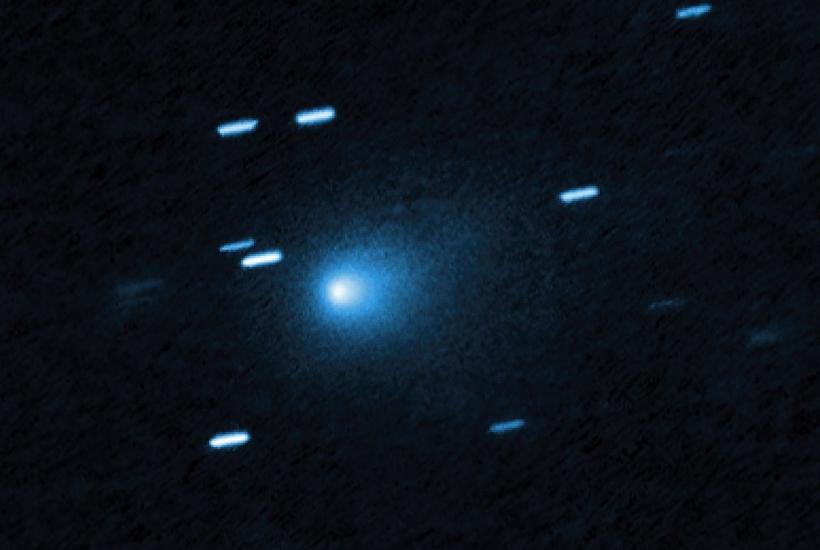Sometimes, discoveries in space don’t just expand our knowledge—they make us pause and consider humanity’s role in the vast cosmos.
The latest interstellar visitor to sweep through our Solar System is doing just that.
In 2017, astronomers spotted Oumuamua, the first object confirmed to have traveled from beyond our Solar System.
Two years later, Borisov’s Comet followed as the second interstellar wanderer.
Now, in 2025, a third object has joined the ranks: 3I/Atlas, a comet detected by the automated ATLAS telescope.
The Third Interstellar Visitor
What makes 3I/Atlas extraordinary is its origin. Its path clearly shows it came from outside the Solar System, moving along a hyperbolic trajectory at a staggering 220,000 kilometers per hour.
This isn’t a body simply drifting from the outer reaches of our neighborhood—it’s a genuine visitor from another star system.
Avi Loeb and the “Trojan Horse” Idea
Harvard professor Avi Loeb, known for his provocative takes on extraterrestrial life, calls 3I/Atlas a “black swan”—a rare, surprising event that could challenge our understanding of the universe.
“It could very well be a natural comet,” Loeb explained in an interview.
“But it might also be a Trojan horse—an extraordinary, low-probability event.
It’s unlikely that an alien craft would suddenly appear, but we can’t rule it out entirely.”
The suggestion echoes debates sparked by Oumuamua, which baffled scientists with its lack of a cometary tail, unexpected acceleration, and reflective surface.
Loeb speculated it could be a fragment of an alien probe, a theory that ignited both skepticism and fresh research into interstellar phenomena.
The Peculiar Tail of 3I/Atlas
Unlike Oumuamua, 3I/Atlas behaves more like a traditional comet, sporting a dust-and-gas tail.
Yet even experienced astronomers are puzzled. Its tail flickers unpredictably, sometimes vanishing entirely, defying conventional models.
Observers have also reported strange deceleration not fully explained by gravity alone.
On October 29, 3I/Atlas reached perihelion—the closest point to the Sun—before slipping behind the solar glare, temporarily out of view.
A Divided Scientific Community
Most experts lean toward a cautious, natural explanation: 3I/Atlas is simply an interstellar comet with unusual behavior caused by uneven heating, volatile sublimation, or partial disintegration of its core.
However, Loeb and a smaller faction argue that the artificial hypothesis deserves consideration.
The logic is straightforward: spotting three interstellar objects in just one decade is statistically improbable.
If even one were artificial, it would upend our understanding of the cosmos.
December 2025: Close Approach to Earth
NASA confirms that 3I/Atlas will make its nearest pass to Earth on December 19, 2025, coming within 0.3 astronomical units—or roughly 45 million kilometers.
While entirely safe, this encounter will give observatories like Hubble and the Atacama telescopes an unprecedented chance to study the comet’s structure and behavior.
Researchers plan to analyze its spectrum for clues—metallic reflections, radio signals, or unusual motion—that might hint at artificial origins.
Interstellar Messengers and Human Curiosity
Ultimately, the fascination with 3I/Atlas says as much about us as it does about the cosmos.
Each interstellar object reminds us that space is not a closed system—matter, and perhaps even technology, travels between stars.
Loeb’s “Trojan horse” metaphor encourages openness to extraordinary possibilities.
History shows that groundbreaking discoveries often begin as ideas that once seemed impossible.
Frequently Asked Questions
When will 3I/Atlas be visible again?
After disappearing behind the Sun on October 29, it will reappear in mid-November.
The optimal observation window lasts through January 2026.
Is there any risk of collision with Earth?
No. The comet will stay about 45 million kilometers away.
Why is it called 3I/Atlas?
“3I” marks it as the third registered interstellar object, while “ATLAS” refers to the telescope system that discovered it—the Asteroid Terrestrial-impact Last Alert System.
Could it be an alien spacecraft?
The odds are extremely low. Scientists continue to examine the data, but no evidence currently points to artificial origin.
When will results from studies be available?
Expect detailed spectral and radio analyses to emerge between December 2025 and January 2026, coinciding with its closest approach to Earth.
